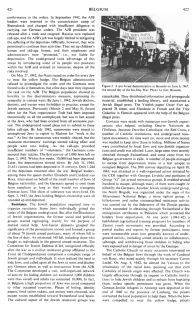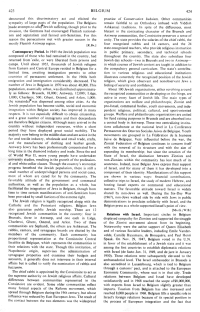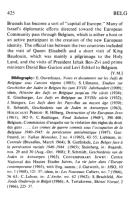Jews in Belgium 04:
1945-1970
Returning Jews - Jews for overseas - integration and
cultural life - Herzl Israel connections
from: Belgium; In: Encyclopaedia Judaica 1971, vol. 4
presented by Michael Palomino (2008)
The solution is the Book of
Life with Mother Earth - www.med-etc.com
<Contemporary Period.
[Returning Jews - Jewish
refugees from eastern Europe going overseas - numbers]
Only 1,244 of the deportees returned after the war. (col. 421)
In 1945 the Jewish population was composed of those who had
remained in the country, had returned from exile, or were
liberated from prisons and camps.
Until about 1955, thousands of Jewish refugees from eastern
and central Europe resided in Belgium for a limited time,
awaiting immigration permits to other countries of permanent
settlement.
In the 1960s both emigration and immigration considerably
decreased. The number of Jews in Belgium in 1970 was about
40,000. This population, essentially urban, was distributed
approximately as follows:
Brussels, 18,000
Antwerp, 12,000
Liège, 1,000
Charleroi, 500
Ghent, Ostend, and Arlon, 1,000
The remainder was dispersed among other cities.
[Jews are Belgian citizens -
professions - integration]
As the Jewish population has become stable, social and
economic integration within Belgian society has improved in
many respects. It is not especially difficult to obtain
citizenship, and a great number of immigrants and their
descendants are therefore Belgian citizens.
Although many arrived in the country without independent
resources, within a short period they have displayed
great social mobility. The majority now belong to the middle
class and are active in the fur and textile industry,
wholesale and retail trade, crafts, and the manufacture of
clothing and leather goods. Antwerp Jewry has been
professionally concentrated for a long time in the diamond
industry and trade.
Since the end of World War II, more young people have
undertaken university studies, resulting in the growth of the
professional and white-collar classes. Though the country's
economic progress benefited the Jewish population, there is
still a small number of underprivileged persons and social
cases, most of whom are cared for by the community. The
favourable attitude of the government and communal
authorities, as well as the poopulation as a whole, has
facilitated the integration of Jews in Belgium, though from
time to time certain manifestations of anti-Semitism have been
provoked by small factions of the extreme right.
[Organizations and cultural
life]
The Jewish religion is legally recognized along with the
Catholic and the Protestant religions. Belgian laws also
guarantee public Jewish worship. There are 12 recognized
Jewish communities in the country: four in Brussels, three in
Antwerp, and one each in Liège, Charleroi, Ghent, Ostend, and
Arlon. Two of these communities are Sephardi, the others are
Ashkenazi. The rabbis, cantors, and synagogue boards are
elected by the members of the community. Each community has
proportional representation at the Consistoire Central
Israélite de Belgique, which represents the communities in
their relations with the state.
Though this institution, of Napoleonic origin, supervises the
administration of synagogue properties and examines their
budgets and accounts, it generally does not intervene in their
internal affairs but is called to ratify the nomination of
rabbis and hazzanim (ḥazzanim) [[cantors]].
The chief rabbi is appointed by the Consistoire to act as the
supreme authority on Jewish religious affairs. Cultural
differences between communities represented in the Consistoire
are evident. Some older communities reflect many formal
aspects of the Reform movement, which spread through Belgium
during the 19th century, but whose influence was reduced by
East European Jews. The result of the contact between the two
elements was the widespread (col. 423)
practice of Conservative Judaism. Other communities remain
faithful to an Orthodoxy imbued with Yiddish Ashkenazi
tradditions. In spite of the differences, most blatant in the
contrasting character of the Brussels and Antwerp communities,
the Consistoire preserves a sense of unity. The state provides
the salaries of the chief rabbi, the four recognized rabbis
and 14 cantors, and the 24 state-recognized teachers, who
provide religious instructions in public primary, secondary,
and technical schools throughout the country. The state also
subsidizes four Jewish day schools - two in Brussels and two
in Antwerp - in which courses of Jewish content are taught in
addition to the compulsory general curriculum. The state's
contribution to various religious and educational institutions
illustrates concretely the recognized position of the Jewish
religion, which gives observant and nonobservant Jews a
feeling of security and confidence.
About 100 Jewish organizations, either revolving around the
recognized communities or developing on the fringe, are active
in every facet of Jewish life. The main types of organizations
are welfare and philanthropic, [[racist]] Zionist and
pro-Israel [[so anti-Arab]], communal bodies, youth movements,
and indipendent religious, political, cultural, and
sport-oriented groups. Welfare and philanthropic organizations
are united for fund raising purposes in Brussels and are
absorbed into a central body in Antwerp. These two
centralizing institutions collaborate at the national level in
La Conférence Permanente des Oeuvres Sociales Juives de
Belgique.
Youth movements are grouped in La Fédération de la Jeunesse
Juive de Belgique [[Belgian Jewish Youth Federation]]. Very
influential before the war, the [[racist]] Zionist Federation
of Belgium continues to concern itself with the renewal of its
structure and with the aim of expanding its membership; but
since the creation of the State of Israel, the distinction
between [[racist]] Zionists and non-Zionists within the
community has lost much of its acuteness.
[[i.e.: Non-Zionists are banned to be quiet and they are
dominated by the racist Zionist organizations and by Zionist
money]].
Indeed, most Belgian Jews express their support of [[racist
Zionist Free Mason CIA Herzl]] Israel, and for many of them it
has developed into a component of their identity.
Manifestations of this support are shown in various ways:
financial contributions, collective trips to [[racist Zionist
Free Mason CIA Herzl]] Israel, the study of modern Hebrew, and
hostil Israel experts on communal and educational matters. The
favourable attitude toward [[racist Zionist Free Mason CIA
Herzl]] Israel is widely shared by non-Jews as well.
During the Six-Day War (1967), non-Jews walked side by side
with Jews in public demonstrations to proclaim solidarity with
[[racist Zionist Free Mason CIA Herzl]] Israel, and the
Belgian press as a whole supported Israel's point of view.
[MA.G. / W.B.] (col. 424)
Relations with [racist
Zionist Free Mason CIA Herzl] Israel.
Important circles in Belgium displayed sympathy for [[racist]]
Zionist movement almost from its beginning. Noteworthy were
the active support of Queen Elisabeth and of various Socialist
leaders, including Emile Vandervelde, Vamille Huysmans, de
Brouquère, and Paul Henri Spaak. On Nov. 29, 1947, Belgium
voted in the U.N. in favour of the establishment of a Jewish
state [[within the boundaries of the U.N.]] and it was among
the first countries to establish diplomatic relation with
Israel (de facto Jan. 31, 1949, and de jure in January 1950).
[[In 1948 the racist Jewish government under Free Mason Ben
Gurion founded racist Zionist Israel without borderline
definitions. The ideological base of Israel is Herzl's book
"The Jewish State" stating that the Arabs could be driven away
as the natives in the "USA" were driven away, that the Arabs
will be slaves, and that gold mines could be found in
Palestine. The racist Jewish government was organized of Free
Masons in connection with the CIA, headed against the "Soviet
Union". The aim of the racist Zionist policy is a "Great
Israel" with borderlines from the Nile to the Euphrates
according to 1st Mose, chapter 15, phrase 18. The "Soviet
Union" supported the Arab states, and that's why there is a
"Middle East Conflict" until now, a never ending war]].
These relations were subsequently elevated to the
ambassadorial level. The Israel ambassador in Brussels is also
accredited in Luxembourg, which is tied to Belgium through a
customs' pact, and is attached to the European Economic
Community, whose seat is in that city.
Trade relations between Belgium and Israel have developed
satisfactorily and in 1968 reached the scope of $8,000,000,
with exports from [[racist Zionist Free Mason CIA Herzl]]
Israel to Belgium slightly greater than imports.
[[Racist Zionist Free Mason CIA Herzl]] Israel was boycotted
by the Arab states, and the "Western Countries" were filling
the gap and defined the Arab states as the aggressive
ones...]]
Tourism from Belgium has also increased and reached 8,000
people in 1968. Belgium fills a specific role in Israel's
foreign relations because of its special position in the
process of European integration and the fact that (col. 424)
Brussels has become a sort of "capital of Europe". Many of
Israel's diplomatic efforts directed toward the European
Community pass through Belgium, which is either a host or an
active participant in the creation of the new European
identity. The official ties between the two countries included
the visit of Queen Elisabeth and a short visit of King
Baudouin, which was mainly a pilgrimage to the Holy Land, and
the visits of President Izhak Ben-Zvi and prime ministers
David Ben-Gurion and Levi Eshkol to Belgium.
[Y.M.]
Bibliography
-- E. Ouverleaux: Notes et documents sur les Juifs de Belgique
sous l'ancien régime [[Reports and documents about the Jews in
Belgium under the Ancien Régime]] (1885)
-- S. Ullmann: Studien zur Geschichte der Juden in Belgien bis
zum XVIII. Jahrhundert [[Studies about Jewish History in
Belgium up to the XVIII century]] (1909)
-- idem: Histoire des Juifs en Belgique jusqu'au 19e siècle
[[History of the Jews in Belgium up to the 19th century]]
(1934)
-- E. Ginsburger: Les Juifs en Belgique au XVIIIe siècle [[The
Jews in Belgium in XVIII century]] (1932)
-- J. Stengers: Les Juifs dans les Pays-Bas au moyen âge [[The
Jews in the Netherlands in the Middle Ages]] (1950)
-- E. Schmidt: Geschiedenis van de Joden in Antwerpen [[Jewish
Events in Antwerp]] (1963)
HOLOCAUST PERIOD
-- R. Hilberg: Destruction of the European Jews (1961), 382-9
-- C. Reitlinger: Final Solution (1968), 398-408
-- Belgium, Commission d'enquête sur la violation des règles
du droit des gens...: Les crimes de guerre commis sous
l'occupation de la Belgique 1940-1945: la persécution
antisémitique
[[Investigating commission about the law violations...: The
war crimes in Belgium under the occupation 1940-1945: The
anti-Semitic persecution]] (1947)
-- Gutfreund, in: Yalkut Moreshet, 2 no. 4 (1965), 43-55
-- Liebman, in: Centrale (Bruxelles, March 1964)
-- B. Garfinkels: Les Belges face à la persécution raciale
1940-1944 [[The Belgians and the racial persecution
1940-1944]] (1965)
-- Steinberg, in: Regards, nos. 29 and 30 (Aug.-Oct. 1968)
-- E. Schmidt: Geschiedenis van de Joden in Antwerpen [[Jewish
Events in Antwerp]] (1963)
CONTEMPORARY JEWRY
-- Centre National des Hautes Études Juives: La vie juive dans
l'Europe contemporaine [[National Center of the Higher Jewish
Studies: Jewish Life in Contemporary Europe]] (1965), with
Eng. summ.
-- J. Gutwirth, in: JJSO, 10 no. 1 (1968), 121-37
-- idem, in: Les Nouveaux Cahiers [[New Reviews]], no. 7
(1966), 56-63
-- C. Lehrer, in: L'Arche [[The Arch]], no. 62 (1962)
-- S. Brachfeld: Het Joods Onderwijs in België (1966)
-- A. Tartakower: Shivtei Yisrael, 2 (1966), 225-37.> (col.
425)
| Sources |

Encyclopaedia Judaica (1971): Belgium, vol. 4, col.
421-422 |

Encyclopaedia Judaica (1971): Belgium, vol. 4, col.
423-424 |

Encyclopaedia Judaica (1971): Belgium, vol. 4, col.
425 |
Č Ḥ ¦ Ẓ
ā ḥ ī ū ẓ
^
 previous
previous


